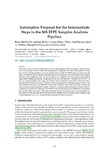Mostrar o rexistro simple do ítem
Automation Proposal for the Intermediate Steps in the 16S FFPE Samples Analysis Pipeline
| dc.contributor.author | Martín de Arribas, Elsa | |
| dc.contributor.author | Conde-Pérez, Kelly | |
| dc.contributor.author | Aja-Macaya, Pablo | |
| dc.contributor.author | Vallejo, J. A. | |
| dc.contributor.author | Poza, Margarita | |
| dc.contributor.author | Ladra, Susana | |
| dc.date.accessioned | 2023-11-10T15:52:03Z | |
| dc.date.available | 2023-11-10T15:52:03Z | |
| dc.date.issued | 2023 | |
| dc.identifier.uri | http://hdl.handle.net/2183/34155 | |
| dc.description | Cursos e Congresos, C-155 | es_ES |
| dc.description.abstract | [Abstract] In the day-to-day work of bioinformatics, the use of integrated software packages, which encompass a wide range of tools, enables the development of pipelines for omics data analysis. Within the various existing pipelines, we focus on the analysis of the 16S rRNA gene as it allows for the study of diversity and taxonomy of prokaryotic microorganisms such as Bacteria and Archaea. However, these pipelines often involve a sequence of multiple tools that require intermediate steps before further processing can proceed, as in the case between Cutadapt and DADA2. In fact, in a typical pipeline, the values for DADA2 input arguments ’trunc-len-f’ and ’trunc-len-r’ are extracted from the output of Cutadapt. The best approach for selecting optimal values (aka the trimming positions) is graphically visualizing Cutadapt output and manually selecting the most accurate trimming position length. Therefore, we propose the automation of this specific intermediate step between Cutadapt and DADA2 tools, by selecting values displayed in the graphs that meet the filtering criteria. This automation has been incorporated into a custom pipeline for the analysis of the microbiome in 16S paired-end samples from colorectal cancer patients, and could potentially serve as a standardization approach in these processes | es_ES |
| dc.description.sponsorship | The authors of this paper extend their sincere appreciation to the collaborative efforts and contributions of the meiGAbiome Group, aswell as the entire team of medical and anatomopathologists. Finally, we are deeply grateful to the patients whose selfless donations have made this and numerous other studies possible | |
| dc.language.iso | eng | es_ES |
| dc.publisher | Universidade da Coruña, Servizo de Publicacións | es_ES |
| dc.relation.uri | https://doi.org/10.17979/spudc.000024.35 | |
| dc.rights | Attribution 4.0 International (CC BY 4.0) | es_ES |
| dc.rights.uri | https://creativecommons.org/licenses/by-nc-sa/4.0/deed.es | * |
| dc.subject | Bioinformática | es_ES |
| dc.subject | Análisis de datos ómicos | es_ES |
| dc.subject | DADA2 | es_ES |
| dc.subject | Cutadapt | es_ES |
| dc.title | Automation Proposal for the Intermediate Steps in the 16S FFPE Samples Analysis Pipeline | es_ES |
| dc.type | info:eu-repo/semantics/conferenceObject | es_ES |
| dc.rights.access | info:eu-repo/semantics/openAccess | es_ES |
| UDC.startPage | 227 | es_ES |
| UDC.endPage | 233 | es_ES |
| UDC.conferenceTitle | VI Congreso Xove TIC: impulsando el talento científico. Octubre, 2023, A Coruña | es_ES |






